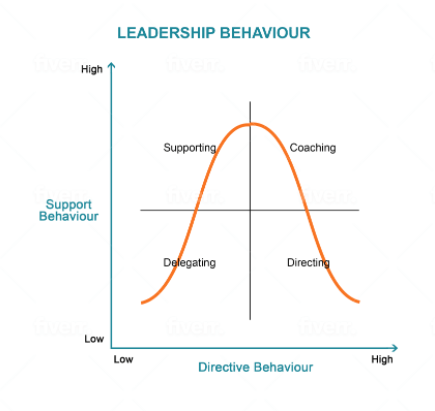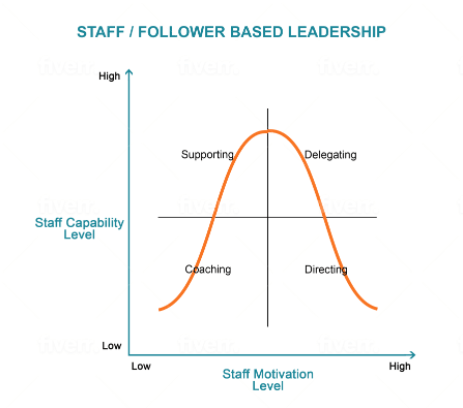Situational Leadership
Situational leadership is an approach to leadership that uses the capability and commitment of team members to determine what type of leadership is needed for successful individual or group performance to accomplish a specific goal. Situational leadership focuses on creating a flexible, adaptive environment that considers both the situation and the team’s capabilities.
A customised approach – the Situational Leadership model
The situational leadership model was developed by Hersey and Blanchard, in 1969, and has been used extensively in organisational leadership training and development.

Team member capability and motivation
As a leader you have a collection of people with different levels of skill, and differing levels of motivation to complete tasks or learn new skills. It might be a generic level of commitment or specialised (my motivation isn’t as high for financial management as it is for planning or customer engagement, as an example).
Under the situational leadership approach, rather than your leadership style being selected by you off your preferences, or your company’s stated values – the leadership style you adopt reflects the capability and motivation level of your team. Either individually or as a group.
At its extreme this means that your leadership style could change for each task and team member. It sounds impractical, and I think it would be if you tried to do this every day. However, the advantage of the situational leadership model is that it gives you a structure to consider each of your team members, and what type of leadership style would suit them best to get the most from them.
Team success is dependent on how well your team understand what you are asking, and how committed they are to achieving the results. Changing your leadership style to the one which will help them most, is something worth considering.

A new look on this model

Leadership styles in more detail
The directive and supportive leadership styles used in the Situational Leadership model can be broken down further into four distinct characteristics.
The first characteristic is “low capability – high motivation”, which is a directing style. In this approach, the leader focuses communication on goal achievement and spends a small amount of time engaging the team or using supportive behaviours. This is useful for low skill/high motivation team or teams.
The second characteristic is “low capability – low motivation”, which is a coaching style. In this approach, the leader focuses on both achieving goals and meeting team socio emotional needs. This requires the leader involve him or herself with the team through giving encouragement and seeking input. However, the leader will still make the final decision on what and how to achieve results. This is useful for a low skill/low motivation team or teams.
The third characteristic is “high capability – low motivation”, which is a supporting style. In this approach, the leader doesn’t focus exclusively on goals, but uses supportive behaviours to bring out followers’ skills around the goal, the supportive style is strong on listening, praising, seeking input and giving feedback. This style gives team members control of their day-to-day decisions and facilitates group problem solving. This type of leader is quick to give recognition. This is useful for high skill/low or high motivation team or teams.
The final characteristic is “high capability – high motivation”, which is a delegating style. In this approach, the leader offers less involvement in planning, control of the details and goal clarification input, as well as less social support, facilitating team members confidence and motivation. In this approach the group agrees on what it is to do and team members take responsibility for getting the job done any way they see fit. This is useful for high skill/high motivation team or teams.
Each one of these approaches is suitable for team – depending on their capabilities and level of motivation. I have generalised the use of each leadership style and encourage you to use this as a guide only. You may find that you get the best from your team or team member using a different leadership style based off their past experience or culture.
Final Thoughts
The Situational Leadership model and approach has several strengths, not least in that it helps you map the capability and commitment of each team member, to enable a level of impartial assessment. This can give you some clear guidance on the level of support and direction each team or member needs to achieve optimal results.
What needs to be kept at the front of your mind is that being flexible in your approach is essential for long term success, as skill level and motivation will change over time.
Be flexible and enjoy learning what works best with your team. I encourage you to overlay this model onto your personal leadership preference and the expectations of your company. If you would like help to go through this exercise, or to develop the various leadership styles outlined above, please contact us for a free discussion.
Author Bio

Deborah Knight is the founder of Xsead Lead with a background in organisational and individual leadership and executive coaching.
As a coach, Deborah aims to create an inclusive and respectful space where individuals and organisations can do the work necessary for growth and change. She is also passionate about helping women be valued for themselves while also contributing and being successful.
Apart from her company which she is deeply passionate about, Deborah also loves bushwalking, reading, travelling, and learning new things.
For any coaching or organisational support enquiries Deborah can be contacted via email: info@xseedlead.com.au or via her company website which is www.xseedlead.com.au.




